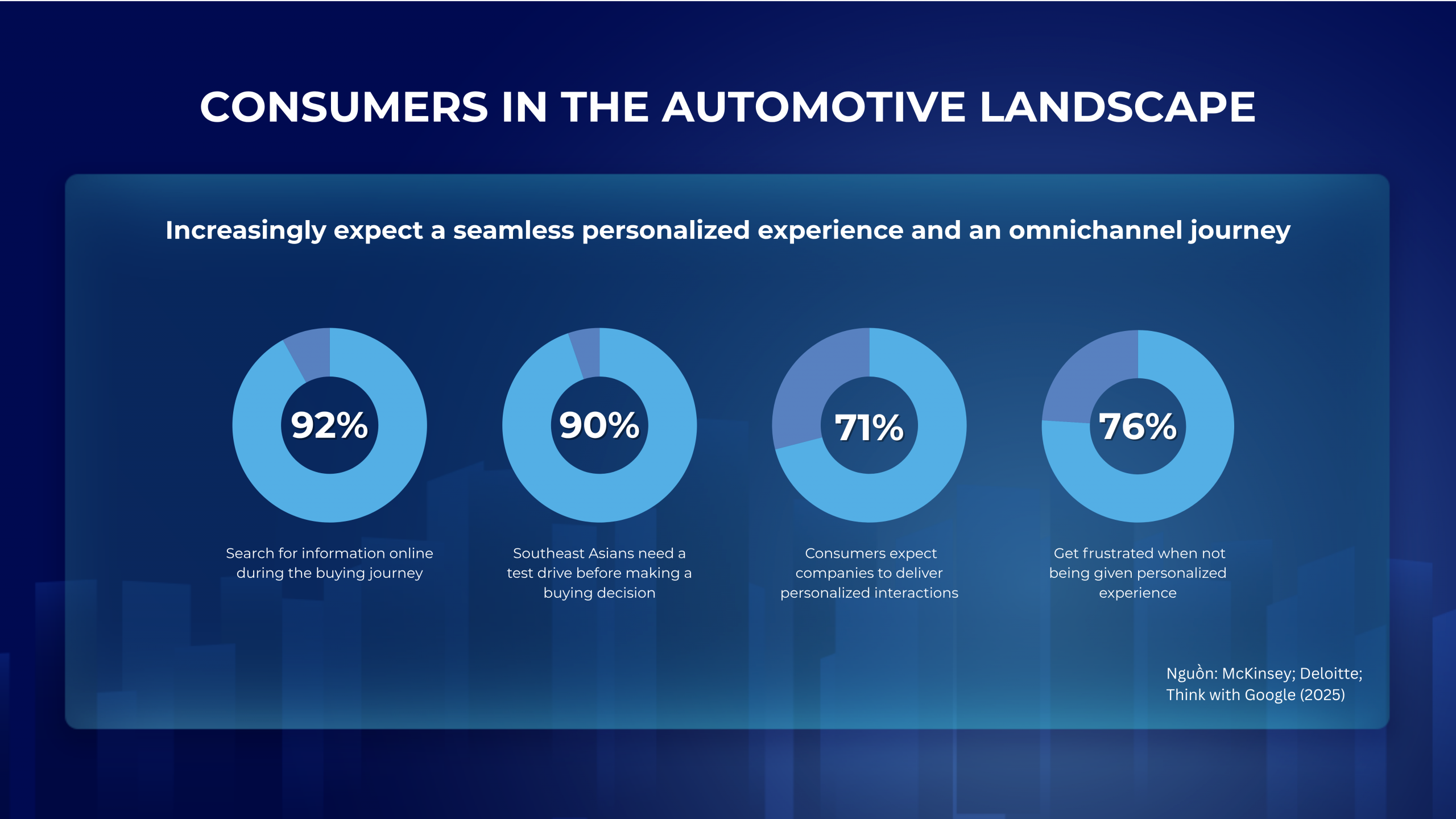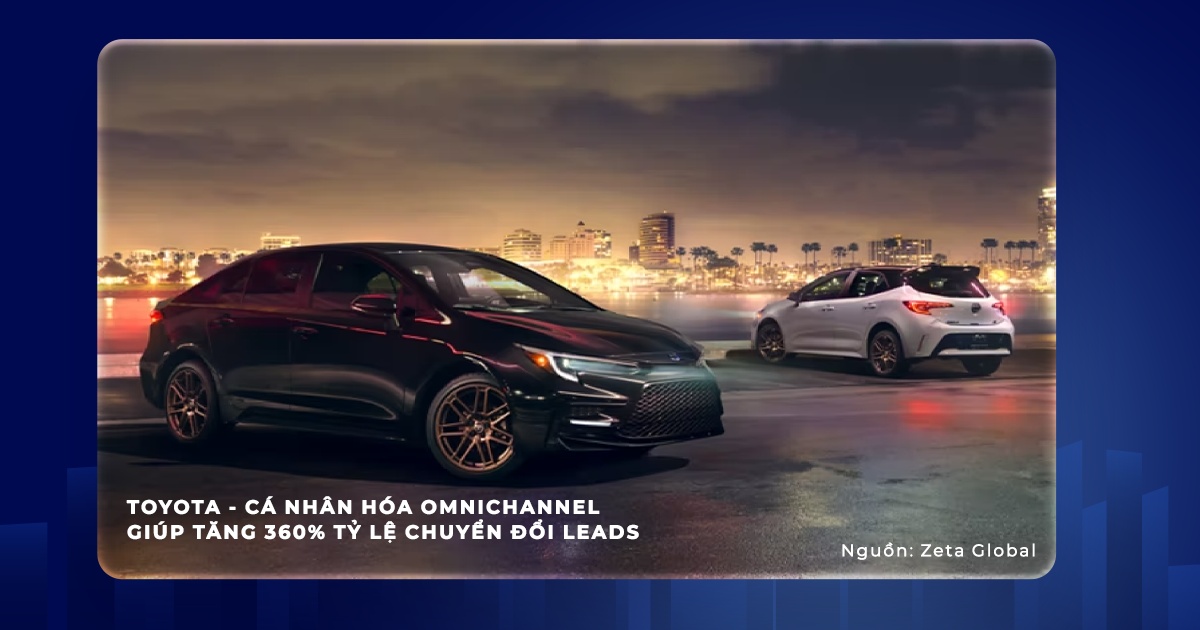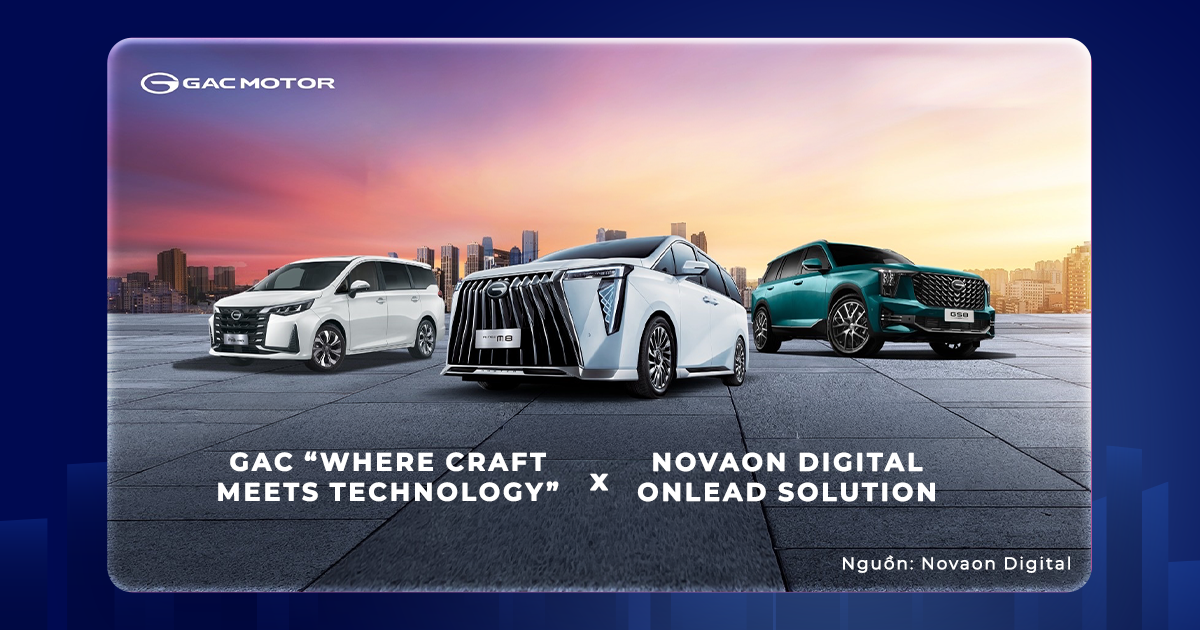In today’s fast-evolving landscape where consumer behavior has become increasingly fragmented and nonlinear, Personalization is no longer just a marketing trend — it has become an essential driver of every Omnichannel Marketing strategy in the automotive industry. But as more automotive brands adopt technology to tailor messages and experiences, what kind of personalization strategy truly differentiates a brand and creates sustainable competitive advantage?
I. Consumers Expect Seamless and Personalized Omnichannel Experiences

Modern automotive shoppers move back and forth between online and offline channels, expecting a unified, consistent experience across touchpoints.
- 92% of car buyers research online before making a purchase decision (Think with Google, 2025).
- Yet, 90% of Southeast Asian consumers still need a physical test drive to feel confident before buying, and 80% want to establish long-term relationships with dealerships for after-sales care (Deloitte, 2025).
At the same time, personalization expectations are rising. According to McKinsey, 71% of consumers expect personalized experiences, while 76% feel frustrated when brands fail to deliver them.
Deloitte’s Global Automotive Study 2025 further shows that:
- 87% of Indian, 80% of Chinese, and 74% of Southeast Asian consumers are willing to pay more for personalized in-car services — even if that means sharing personal data.
- Most consumers trust OEMs to manage vehicle and customer data responsibly, providing a solid foundation for scalable personalization strategies.
As a result, building an integrated omnichannel marketing journey has become a top strategic priority for automakers. And at the heart of that transformation lies one core principle: Personalization — creating a connected and individualized brand experience across every touchpoint.
II. How Automakers Are Deploying Personalized Omnichannel Marketing
According to McKinsey (2025), companies that lead in personalization achieve 40% faster revenue growth and 30% higher profit margins than competitors — largely because they can translate customer data into tailor-made experiences.
Leading automotive brands are approaching personalization systematically, built around two core pillars:
- Personalizing content and engagement based on behavioral data
- Integrating and automating the omnichannel customer journey
1. Data-Driven Personalization of Content and Interactions
The foundation of personalization lies in an organization’s ability to collect, unify, and activate customer behavioral and intent data.
Moving beyond basic demographic segmentation, leading OEMs now identify “Moments of Truth” throughout the purchase journey — predicting behaviors and mapping multi-touch interactions to understand individual intent.
The next step is to turn this insight into action — transforming data into tailored experiences.
Personalization today means more than adding a name to an email; it means adapting the entire brand experience to match customer behavior and buying stage, through:
- Dynamic Content & Overlay Ads: Real-time website or app content that shifts based on user behavior.
- AI-Driven Recommendations: Suggesting car models, configurations, or financing options aligned with user interests.
- Behavioral Triggers: Activating communications based on behavioral signals — for instance, retargeting a customer who has viewed a specific model multiple times.
2. Integrated Customer Journeys – Turning Experience into a Brand Asset
The second pillar, and often the hardest, is achieving a seamless integration of customer experiences across channels.
In many organizations, online behavioral data (e.g., model views or quote requests) stays within marketing teams, while dealer data (e.g., test drive feedback, financing preferences, purchase status) rarely flows back upstream.
This disconnect limits the brand’s ability to optimize campaigns and understand true performance.
Leading brands are overcoming this gap through a two-way data loop:
- Marketing shares leads with behavioral context (e.g., “visited the hybrid model page three times, viewed financing offers”).
- Dealers feed back interaction outcomes (“booked test drive,” “postponed purchase,” or “bought competitor model”).
- Marketing then refines its messaging and timing based on these real-world responses.
III. Case Studies from Leading Automotive Brands
1. Toyota: Personalized Omnichannel Strategy Boosts Lead Conversion by 360%

Challenge:
Despite attracting high and consistent website traffic, Toyota struggled to channel visitors toward Tier 2 and Tier 3 dealerships.
Their marketing tech stack lacked the capability to connect campaigns across different channels, meaning users who left the manufacturer site without visiting dealer sites were lost in the funnel.
When leads did reach dealers, attribution was unclear and dealer DMS data wasn’t being leveraged for remarketing — creating a fragmented, impersonal buying experience.
Solution:
To unlock growth, Toyota restructured its marketing model — shifting from channel-based to integrated, customer-centric personalization. Partnering with Zeta Global, the company implemented an AI-driven marketing platform that:
- Linked anonymous web data with known customer profiles.
- Enabled personalized retargeting via email, display, and social channels to drive dealer visits.
- Integrated dealer DMS and online behavioral data to pinpoint customers’ exact journey stage.
Results:
Toyota achieved an 87% increase in CTR and a 360% surge in lead conversion rates.
Following this success, the brand scaled the initiative into an always-on personalization strategy across markets.
2. GAC Motor: “Where Craft Meets Technology” – Driving Growth Through Automation and Personalization

Challenge:
As a new entrant in the premium gasoline segment, GAC Motor faced skepticism about product quality and origin.
Vietnamese consumers are highly price-sensitive yet demand premium service — while GAC’s lead management process was still manual and fragmented, resulting in lead loss and slow response times.
Solution:
GAC partnered with Novaon Digital to deploy OnLead Management, an automation platform designed to centralize and accelerate lead operations.
- Leads were captured in real-time from paid, owned, and social channels, consolidated into a unified MiniCRM.
- The system automatically de-duplicated, scored, and assigned leads to the right sales teams.
- Two-way data synchronization with CRM and Meta Conversion API enabled budget optimization and full-funnel visibility.
Results:
Within the first campaign phase, GAC generated 1,667 leads, including 800 high-quality leads — leading to 89 car sales.
Lead response time dropped to under 10 minutes, establishing GAC Motor’s image as a modern, customer-centric automotive brand in Vietnam.
IV. Expert Insights from Novaon Digital
Personalized Omnichannel Marketing is not just about technology — it’s about building a cohesive ecosystem where data, creativity, and customer experience converge.
To succeed, automakers should:
- Design personalized messages for every stage of the customer journey, reflecting behavioral signals and emotional triggers.
- Standardize data flow between marketing, sales, and dealerships to ensure feedback loops for continuous optimization.
- Integrate Martech solutions like OnLead, OnMarketer, and NOVAON Chatbot to automate, personalize, and scale engagement across touchpoints.
At Novaon Digital, we combine Strategy – Creativity – Technology to help automotive brands turn insights into measurable growth.
Beyond automation and lead management, we help brands craft stories and experiences that feel designed for every driver — at the right time, with the right emotion.
V. Conclusion
Personalization is redefining the competitive standard in the automotive industry — where data, creativity, and experience merge into one continuous journey.
Automotive brands must act decisively in their digital transformation to harness martech and build truly Personalized Omnichannel Experiences.
When automakers and dealerships operate within a unified data ecosystem and a shared brand experience framework, they don’t just boost sales —
they earn trust, loyalty, and emotional connection from every driver across the ownership lifecycle.


